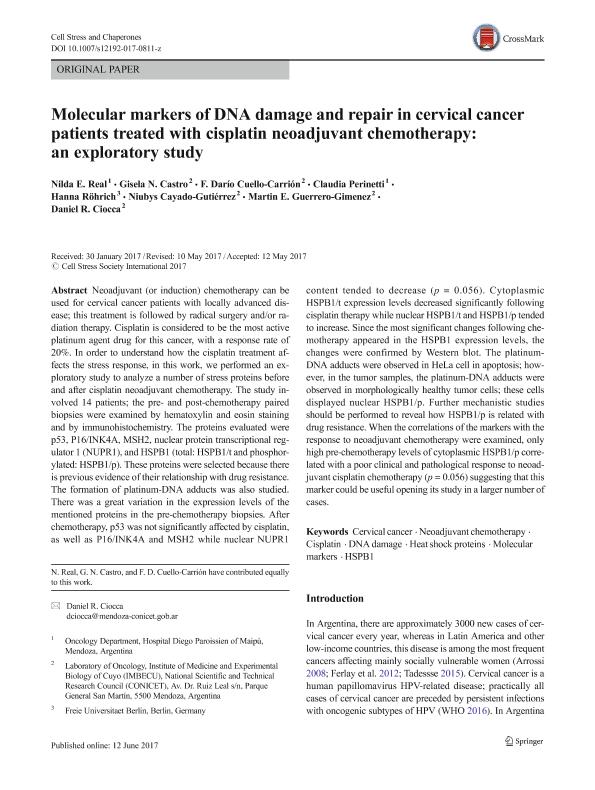Mostrar el registro sencillo del ítem
dc.contributor.author
Real, Nilda E.
dc.contributor.author
Castro, Gisela Natalia

dc.contributor.author
Cuello Carrión, Fernando Darío

dc.contributor.author
Perinetti, Claudia
dc.contributor.author
Röhrich, Hanna
dc.contributor.author
Cayado Gutiérrez, Niubys de Los Milagros

dc.contributor.author
Guerrero Gimenez, Martin Eduardo

dc.contributor.author
Ciocca, Daniel Ramon

dc.date.available
2018-06-22T20:55:07Z
dc.date.issued
2017-11
dc.identifier.citation
Real, Nilda E.; Castro, Gisela Natalia; Cuello Carrión, Fernando Darío; Perinetti, Claudia; Röhrich, Hanna; et al.; Molecular markers of DNA damage and repair in cervical cancer patients treated with cisplatin neoadjuvant chemotherapy: an exploratory study; Springer; Cell Stress & Chaperones; 22; 6; 11-2017; 811-822
dc.identifier.issn
1355-8145
dc.identifier.uri
http://hdl.handle.net/11336/49801
dc.description.abstract
Neoadjuvant (or induction) chemotherapy can be used for cervical cancer patients with locally advanced disease; this treatment is followed by radical surgery and/or radiation therapy. Cisplatin is considered to be the most active platinum agent drug for this cancer, with a response rate of 20%. In order to understand how the cisplatin treatment affects the stress response, in this work, we performed an exploratory study to analyze a number of stress proteins before and after cisplatin neoadjuvant chemotherapy. The study involved 14 patients; the pre- and post-chemotherapy paired biopsies were examined by hematoxylin and eosin staining and by immunohistochemistry. The proteins evaluated were p53, P16/INK4A, MSH2, nuclear protein transcriptional regulator 1 (NUPR1), and HSPB1 (total: HSPB1/t and phosphorylated: HSPB1/p). These proteins were selected because there is previous evidence of their relationship with drug resistance. The formation of platinum-DNA adducts was also studied. There was a great variation in the expression levels of the mentioned proteins in the pre-chemotherapy biopsies. After chemotherapy, p53 was not significantly affected by cisplatin, as well as P16/INK4A and MSH2 while nuclear NUPR1 content tended to decrease (p = 0.056). Cytoplasmic HSPB1/t expression levels decreased significantly following cisplatin therapy while nuclear HSPB1/t and HSPB1/p tended to increase. Since the most significant changes following chemotherapy appeared in the HSPB1 expression levels, the changes were confirmed by Western blot. The platinum-DNA adducts were observed in HeLa cell in apoptosis; however, in the tumor samples, the platinum-DNA adducts were observed in morphologically healthy tumor cells; these cells displayed nuclear HSPB1/p. Further mechanistic studies should be performed to reveal how HSPB1/p is related with drug resistance. When the correlations of the markers with the response to neoadjuvant chemotherapy were examined, only high pre-chemotherapy levels of cytoplasmic HSPB1/p correlated with a poor clinical and pathological response to neoadjuvant cisplatin chemotherapy (p = 0.056) suggesting that this marker could be useful opening its study in a larger number of cases.
dc.format
application/pdf
dc.language.iso
eng
dc.publisher
Springer

dc.rights
info:eu-repo/semantics/openAccess
dc.rights.uri
https://creativecommons.org/licenses/by-nc-sa/2.5/ar/
dc.subject
Cervical Cancer
dc.subject
Cisplatin
dc.subject
Dna Damage
dc.subject
Heat Shock Proteins
dc.subject
Hspb1
dc.subject
Molecular Markers
dc.subject
Neoadjuvant Chemotherapy
dc.subject.classification
Medicina Critica y de Emergencia

dc.subject.classification
Medicina Clínica

dc.subject.classification
CIENCIAS MÉDICAS Y DE LA SALUD

dc.title
Molecular markers of DNA damage and repair in cervical cancer patients treated with cisplatin neoadjuvant chemotherapy: an exploratory study
dc.type
info:eu-repo/semantics/article
dc.type
info:ar-repo/semantics/artículo
dc.type
info:eu-repo/semantics/publishedVersion
dc.date.updated
2018-06-18T19:10:22Z
dc.journal.volume
22
dc.journal.number
6
dc.journal.pagination
811-822
dc.journal.pais
Alemania

dc.journal.ciudad
Berlin
dc.description.fil
Fil: Real, Nilda E.. Hospital Diego Paroissien; Argentina
dc.description.fil
Fil: Castro, Gisela Natalia. Consejo Nacional de Investigaciones Científicas y Técnicas. Centro Científico Tecnológico Conicet - Mendoza. Instituto de Medicina y Biología Experimental de Cuyo; Argentina
dc.description.fil
Fil: Cuello Carrión, Fernando Darío. Consejo Nacional de Investigaciones Científicas y Técnicas. Centro Científico Tecnológico Conicet - Mendoza. Instituto de Medicina y Biología Experimental de Cuyo; Argentina
dc.description.fil
Fil: Perinetti, Claudia. Hospital Diego Paroissien; Argentina
dc.description.fil
Fil: Röhrich, Hanna. Freie Universitaet Berlin; Alemania
dc.description.fil
Fil: Cayado Gutiérrez, Niubys de Los Milagros. Consejo Nacional de Investigaciones Científicas y Técnicas. Centro Científico Tecnológico Conicet - Mendoza. Instituto de Medicina y Biología Experimental de Cuyo; Argentina
dc.description.fil
Fil: Guerrero Gimenez, Martin Eduardo. Consejo Nacional de Investigaciones Científicas y Técnicas. Centro Científico Tecnológico Conicet - Mendoza. Instituto de Medicina y Biología Experimental de Cuyo; Argentina
dc.description.fil
Fil: Ciocca, Daniel Ramon. Consejo Nacional de Investigaciones Científicas y Técnicas. Centro Científico Tecnológico Conicet - Mendoza. Instituto de Medicina y Biología Experimental de Cuyo; Argentina
dc.journal.title
Cell Stress & Chaperones

dc.relation.alternativeid
info:eu-repo/semantics/altIdentifier/url/https://link.springer.com/article/10.1007%2Fs12192-017-0811-z
dc.relation.alternativeid
info:eu-repo/semantics/altIdentifier/doi/http://dx.doi.org/10.1007/s12192-017-0811-z
Archivos asociados
